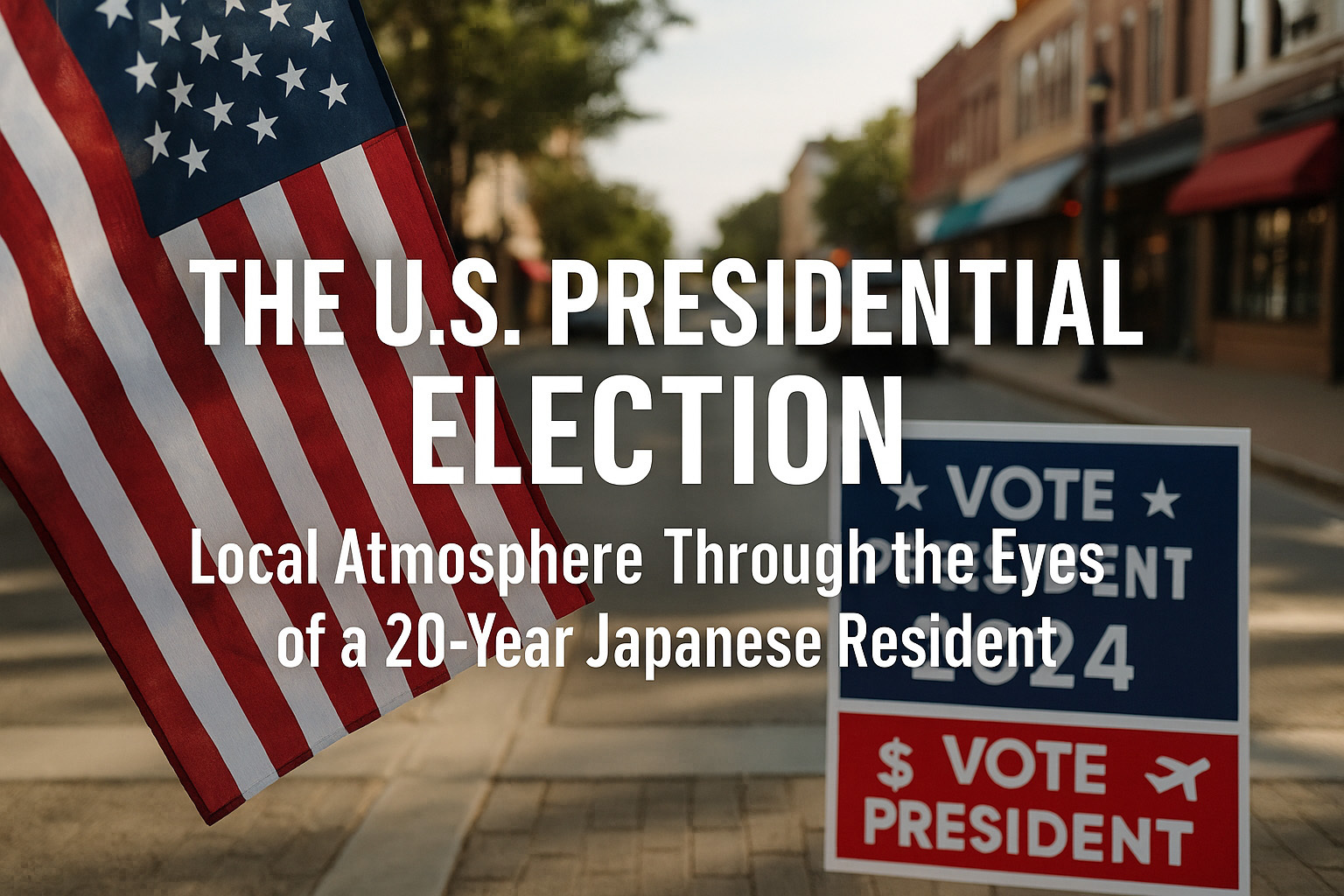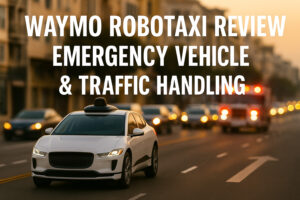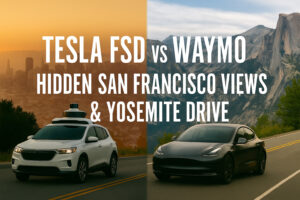The U.S. Presidential Election: Local Atmosphere Through the Eyes of a Japanese Resident of 20 Years

What’s at Stake in the 2024 U.S. Presidential Election?
Hi—Suzuki here from Eco Drive.
In this post I’ll share what it feels like to experience a U.S. presidential race up close, and then dive into the key themes shaping the 2024 contest.
The first half is a broad, evergreen look at how U.S. elections work, so even if you’re reading this after 2024, you’ll still find plenty of useful context.
Prefer video? Watch the full breakdown here:
The videos embedded in this article are narrated in Japanese, but English subtitles are available.
1. Voter Engagement Runs Deep in the United States

First, let’s talk about how seriously Americans take their elections.
I’ve lived in the U.S. since 2004 and have been through several campaign cycles.
What always strikes me is the sheer level of public engagement—especially when the White House is on the line.
During a presidential year the atmosphere shifts up a gear: candidates blanket every media channel, debates dominate prime time, and whole communities rally around voter drives.
The result is a nation that treats Election Day like a civic Super Bowl—everyone has an opinion, and nearly everyone shows up to play.
Campaign Season Transforms the Look and Feel of Every Town
Once election season kicks into gear, you can literally feel it on the streets.
Volunteers line busy intersections waving oversized placards, pitching their candidate to passing cars and pedestrians.
Ordinary households join in, too—yard signs and porch banners shout, “This home backs Trump!” or “We’re with Hillary!”
In Japan, most campaigning is handled by the candidate’s own team, but in the U.S. community members roll up their sleeves and get involved at a grass-roots level.
One company I worked for had a big parking lot and some spare office space; during the Obama years, we even donated the site as an official polling station—run entirely by local volunteers.
Turnout Is Relatively High, Too
That grass-roots energy shows up in the numbers on Election Day.
In the 2020 presidential race, 66.8 % of eligible Americans cast a ballot—roughly two-thirds of the electorate.
For comparison, turnout in Japan’s most recent Lower House election was about 55 %, a gap of more than 15 percentage points.
America’s Two-Party System: Democrats vs. Republicans

Two main factors, in my view, drive this high level of civic engagement.
The first is America’s entrenched two-party system.
Every presidential race comes down to a Democrat versus a Republican.
Choosing a president therefore means choosing which party—and which worldview—will steer the country for the next four years.
Because policy agendas differ sharply between the parties, the election outcome can reshape national priorities and touch people’s day-to-day lives in very tangible ways—so voters pay close attention.
How Does Japan Compare?
Japan, by contrast, posts some of the lowest turnout numbers among industrialized nations.
A big reason, many analysts argue, is that the Liberal Democratic Party has held power for most of the post-war era.
When voters assume the ruling party won’t change, they often feel the election won’t change much either.
That “nothing will really be different no matter who wins” mindset—especially common among younger voters—helps explain why so many stay home on polling day.
A Direct Vote for the Nation’s Top Leader
Another turnout booster is the way the United States actually picks its president—by direct popular vote (filtered through the Electoral College), rather than through an internal party process.
Because citizens feel they themselves are choosing the country’s top decision-maker, their personal stake in the outcome naturally rises.
Add to that a distinctly American fondness for “hero” narratives.
From comic books to blockbuster movies, U.S. pop culture loves a champion who swoops in and defeats the bad guys.
Many voters bring that same mindset to politics: they want a strong leader who can break the gridlock and “save the day.”
That yearning for a decisive hero is part of what keeps the presidential race front-and-center in the public imagination.
2. How Democrats and Republicans Differ
The second topic is the key differences between the two major parties.
Democrats are generally described as “liberal.”
In American politics, liberal means prioritizing diversity while pursuing social fairness and equality. Democrats tend to favor innovation and progress over strict adherence to tradition.
Policy areas they traditionally emphasize include:
- Social safety nets and public assistance
- Education funding
- Environmental protection
- Expanding access to healthcare
- Raising the minimum wage
- Combating climate change
The party’s color is blue, and states that reliably vote Democratic are nicknamed “blue states.”
Republicans, by contrast, are known as “conservative.”
Conservatives are generally cautious about rapid change and place a higher value on traditional principles, social order, and limited government intervention.
Their core policy focus has historically been:
- Economic growth through free-market policies
- National defense and military strength
- Tax cuts to spur investment and job creation
The GOP’s signature color is red, and states that lean Republican are called “red states.”
Who Backs Each Party?
Traditionally, Democrats have drawn much of their strength from blue-collar and unionized workers—voters who see the party as a champion of wages, workplace protections, and social programs.
The Republican base was once dominated by college-educated white voters who favored low taxes and limited government.
But voting blocs are shifting.
In recent cycles, a noticeable slice of Hispanic and Black voters—groups that leaned Democratic for decades—have moved toward the GOP.
Where these communities ultimately land could decide the next election, making them the swing constituency both parties are chasing hardest.
3. When the President Changes, the Mood of the Nation Shifts

For our third point, let me share how the country’s atmosphere has shifted each time a new president took office.
During my years in the U.S. I’ve lived through several transitions, and each one felt like the nation hit the reset button on its overall mood.
Take 2009, when George W. Bush handed the keys to Barack Obama—just months after the Lehman Brothers collapse.
The economy was in free-fall, and I remember Japanese companies pulling up stakes and retreating home.
Obama’s team quickly rolled out major stimulus programs.
Unemployment, which had been climbing relentlessly, finally leveled off, and a sense of optimism crept back into everyday conversation.
You could literally feel the country’s outlook brighten as the recovery slowly took hold.
How the Obama Years Affected Everyday Life: Enter Obamacare
The single most memorable policy shift of the Obama era was the Affordable Care Act—better known as “Obamacare.”
For me, it was a lifesaver.
Back in late 2001 I quit my salaried job to start my own business.
Along with my corporate ID badge, I also gave up employer-sponsored health coverage—and I had no idea how steep individual premiums could be.
The sticker shock was real. Cash flow at a brand-new startup is razor-thin, and I simply didn’t have thousands of dollars to throw at private insurance.
Going uninsured wasn’t an option, but paying full freight looked impossible—until Obamacare rolled out.
Because the law ties subsidies to your income, I qualified for significant help. Overnight my monthly premium dropped to a level a young entrepreneur could actually afford.
That financial breathing room let me keep building the business instead of scrambling just to cover medical bills.
Clean-Energy Push Under Obama: A Quieter, Greener Roadway
Another signature move by the Obama administration was its big bet on clean energy.
New fuel-economy standards spurred automakers to roll out ever-thriftier models, and EV development kicked into high gear.
Back in 2008–2009 gasoline prices spiked to eye-watering highs.
Overnight the public fell in love with hybrids like the Prius, trading thirsty SUVs for fuel-sippers at a record pace.
Federal rebates sweetened the deal, so new-car sales surged—and the average vehicle on the road got noticeably newer and more efficient.
The vibe on the streets changed, too.
Where once lifted SUVs and drag-strip exhausts shook the pavement, they gradually gave way to quieter, cleaner cars.
I remember thinking: the whole city just sounded calmer.
What Changed When Trump Took Office

The hand-off from Barack Obama to Donald Trump came with a crystal-clear slogan: “Make America Great Again.”
That rallying cry fueled huge expectations—especially in the business community—that Trump could deliver a dramatic economic turnaround.
The marquee policy was an aggressive tax overhaul.
Corporate tax rates plunged from 35 % to 21 %, freeing up cash for companies to pour into new plants, equipment, and hiring.
Wages climbed, payrolls expanded, and profits swelled—sparking a powerful bull run on Wall Street.
GDP growth accelerated, and unemployment fell into the 3 % range—its lowest level in half a century.
With the U.S. economy humming, more Japanese firms jumped into the market, and the business landscape felt genuinely super-charged.
Pandemic Response Under the Trump Administration
When COVID-19 hit in 2020, the U.S. economy took a massive hit—but Washington moved fast with sweeping relief measures.
Personally, I never felt distrust or frustration toward the federal response, and I rarely heard complaints from fellow business owners.
What stood out most was the speed: stimulus checks, payroll-protection loans, emergency grants—new programs seemed to roll out almost overnight.
And it wasn’t just top-down aid. At the community level, local groups mobilized donation drives and mutual-aid funds in record time.
Rather than skepticism, I felt a sense of “Only in America”—confidence that the government and our neighbors alike would step up and make sure no one was left behind.
4. Looking Ahead to the 2024 Election
With all that history in mind, where does the race stand today?
The GOP is running former President Donald Trump, while the Democrats have put forward Vice President Kamala Harris.
Most polling shows a razor-thin margin, but the consensus right now gives Trump a slight edge.
Whoever wins will steer the country in very different directions.
- If Trump returns to the White House we’d likely see a renewed focus on pro-business tax and regulation cuts, plus a tougher line on immigration.
- If Harris prevails expect a stronger push for liberal social programs, climate action, and an expanded safety net.
Trump’s path to victory would rest on three pillars:
1 ) an intensely loyal base,
2 ) the economic track record many remember from his first term, and
3 ) the perception that his business instincts can once again jump-start growth.
Donald Trump vs. Kamala Harris

Even critics concede that Trump’s first term was—love it or hate it—largely “promise made, promise kept.”
He also delivered his share of inflammatory rhetoric, especially on immigration, and those remarks still cast a shadow.
Yet for many voters the perceived results—tax cuts, a booming stock market, low unemployment—outweighed the controversies.
Harris, meanwhile, vaulted into the spotlight as Joe Biden’s designated successor.
Some pundits argue her media “honeymoon” may have been her high-water mark so far.
She hasn’t fully fleshed out a signature policy slate, and—despite an impressive résumé as a former prosecutor and California attorney general—skeptics question how she would perform as commander-in-chief.
5. How 2024 Differs from the 2016 Trump-Clinton Showdown
The Trump-versus-Hillary race in 2016 was a global media spectacle.
Back then, public opinion toward Donald Trump felt far more skeptical.
Many—including myself—wondered whether a candidate with so little political experience could really handle the Oval Office.
Fast-forward to today and the mood has shifted.
Four years in the White House gave voters a front-row seat to Trump’s business-style decision-making and executive instincts.
As a result, the 2024 conversation is less about “Can he do the job?” and more about whether people liked the results they saw the first time around.
A Brush With Assassination—Luck Still on His Side
The recent assassination attempt was nothing short of shocking.
A bullet whizzed past Trump’s face, missing by inches—an escape that can only be called miraculous.
The now-iconic photo of him, blood running down his cheek while he thrusts a fist skyward beneath the American flag, felt like an image straight out of a textbook on U.S. leadership.
I’m not the only one who came away thinking, “This man seems to have fate on his side.” Many Americans appeared to draw the same conclusion.
Heading into November, the question is how voters will weigh that dramatic moment—and Trump’s prior record—when they decide whether to give him a second term.
6. How the Trump Years Looked From a Business Owner’s Chair
From an entrepreneur’s standpoint, the previous Trump administration was a decidedly pro-business era.
Broad tax cuts and aggressive deregulation reshaped the playing field almost overnight.
My own company was able to ramp up capital spending and hire more staff—opportunities we could not have afforded under the old tax burden.
We weren’t alone. Across the U.S. many small- and mid-sized firms used those savings to expand operations, launch new product lines, and generally take risks they might otherwise have postponed.
What Would a Second Trump Term Mean for the EV Industry?

Under a Democratic administration, environmental protections and social programs usually get a boost.
A return to a Trump-led GOP, however, could put extra pressure on certain industries.
The former president has already said he would eliminate federal incentives for electric vehicles—a change that could sting automakers, battery suppliers, and charging-network companies alike.
Without those tax credits and rebates, the entire EV ecosystem might find its growth curve flattening just as it’s gearing up for mass adoption.
Will Immigration Rules Tighten Again?
Immigration is the other big wild card.
If Washington makes work visas harder to get, companies like ours—staffed largely by expats—could struggle to secure talent.
Fewer new arrivals would also shrink our potential customer base and, in turn, our revenue.
Looking Back at Trump’s First Term
The interesting thing is that during Trump’s previous four years, most of those worst-case fears never materialized for legal applicants.
Policy crackdowns focused mainly on undocumented immigration, while properly filed visa petitions continued to move forward much as before.
So while the rhetoric can sound tough, the practical impact on law-abiding foreign workers might again prove limited.
Yes, there are legitimate concerns. But weighing the pros and cons, I suspect the broader economy—thanks to pro-business tax and regulatory stances—could still net out positive over the long run.
In short, each administration brings trade-offs, yet from a strictly business perspective a second Trump term would likely tilt the playing field in favor of owners and entrepreneurs.
Our Services
We offer comprehensive automotive solutions—buy, sell, rent, and repair in one place.
Car Sales
Browse our lineup of quality used cars with transparent pricing and up to a two-year warranty on select models.
View InventoryAuto Repair
Get expert service from our certified Toyota Master Mechanic. We primarily service Toyota vehicles.
Schedule ServiceTrade-in / Sell
We pay top dollar for your vehicle—especially hybrids. Count on fair, transparent appraisals.
Get EstimateCar Rentals
Choose between fuel-saving hybrid rentals and a Tesla with Full Self-Driving Capability—both at competitive rates.
Reserve Now





